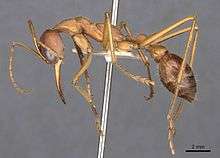Myrmecia vindex
Myrmecia vindex is a species of Myrmecia which is native in Australia. As a subgroup of the Myrmecia gulosa species group, these ants are also commonly known as the Bull Ant.[1] The Myrmecia vindex was collected and described by Frederick Smith in 1858.[2]
| Myrmecia vindex | |
|---|---|
 | |
| M. vindex worker | |
| Scientific classification | |
| Kingdom: | |
| Phylum: | |
| Class: | |
| Order: | |
| Family: | |
| Subfamily: | |
| Genus: | |
| Species: | M. vindex |
| Binomial name | |
| Myrmecia vindex F. Smith, 1858 | |
Appearance
Myrmecia vindex's are around 21 millimetres long on average, and they have normally have a red head, and a black abdomen. Their mandibles are long, strongly toothed, and appears in a yellow palish colour.[3]
Habitat
These ants are commonly found in western Australia, but also ranges further into South Australia. They prefers to live in open, dry woodland habitat.[4]
Behavior
The nocturnal M. vindex relies exclusively on vision for navigation with eyes having ultraviolet-, blue- and a green-sensitive photoreceptor cells.[5] Compared to other species within the genus Myrmecia, M. vindex are socially less evolved and typically have small populations. During the height of their breeding season, Myrmecia vindex commonly pile discarded cocoons and shed exoskeletons on the crater of their nest, near the entrance.[4]
References
- Ogata K, Taylor RW (December 1991). "Ants of the genus Myrmecia Fabricius: a preliminary review and key to the named species (Hymenoptera: Formicidae: Myrmeciinae)". Journal of Natural History. 25 (6): 1623–1673. doi:10.1080/00222939100771021.
- "Myrmecia vindex". AntWeb.
- Wheeler GC, Wheeler I (October 1971). "Ant larvae of the subfamily Myrmeciinae (Hymenoptera: Formicidae)". The Pan Pacific Entomologist. 47 (4): 245–256.
- Haskins CP, Haskins EF (January 1974). "Notes on Necrophoric Behavior in the Archaic Ant Myrmecia Vindex (Formicidae: Myrmeciinae)" (PDF). Psyche: A Journal of Entomology. 81 (2): 258–267. doi:10.1155/1974/80395.
- Ogawa Y, Falkowski M, Narendra A, Zeil J, Hemmi JM (June 2015). "Three spectrally distinct photoreceptors in diurnal and nocturnal Australian ants". Proceedings. Biological Sciences. 282 (1808): 20150673. doi:10.1098/rspb.2015.0673. PMC 4455814. PMID 25994678.